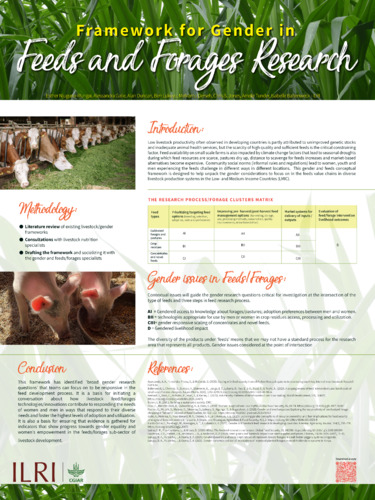Framework for gender in feeds and forages research
Abstract
Low livestock productivity often observed in developing countries is partly attributed to unimproved genetic stocks and inadequate animal health services, but the scarcity of high-quality and sufficient feeds is the critical constraining factor. The livestock feed challenge persists despite many investment programs focused on livestock feed research and development over the past three decades. Feed availability on small-scale farms is also impacted by climate change factors that lead to seasonal droughts during which feed resources are scarce, pastures dry up, distance to scavenge for feeds increases and market-based alternatives become expensive. The limited availability of feed during the dry season results in sizeable seasonal fluctuation in milk (or other products) production and, in extreme cases, producers lose their livestock. Community social norms (informal rules and regulations) lead to women, youth and men experiencing the feeds challenge in different ways in different locations. This gender and feeds conceptual framework is designed to help unpack the gender considerations to focus on in the feeds value chains in diverse livestock production systems in lowand medium-income countries (LMIC). It focuses on how, where, and which gender considerations matter in feed-resource targeting, feed-option improvement, and feed input/output marketing and delivery. The aim is to positively affect the knowledge about and adoption of improved feed technologies and innovations, among men and women farmers, to ultimately contribute to enhanced livestock production in the smallholder systems in LMIC as a component of agri-food systems.

